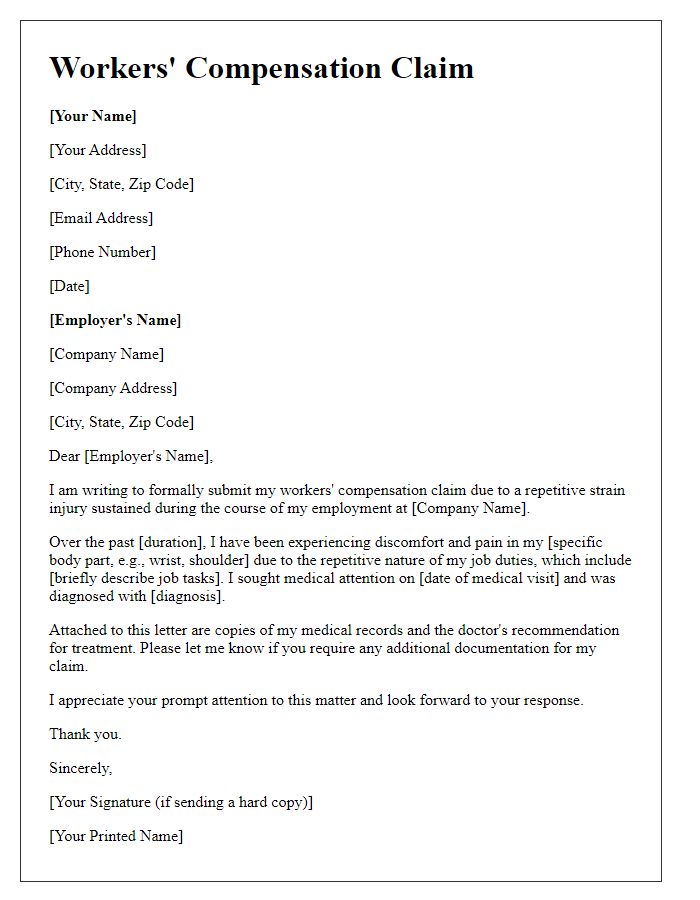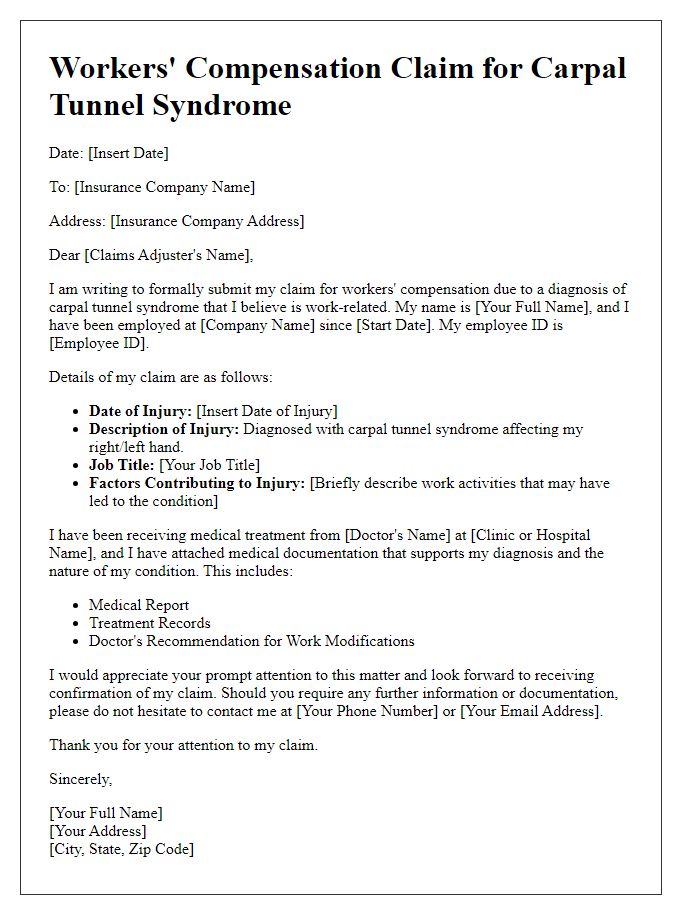When navigating the complexities of a workers' compensation claim, having the right letter template can make all the difference in securing what you deserve. This guide will help you craft a clear and concise letter that outlines your situation, including the details of your injury and the circumstances surrounding it. By following our suggestions, you'll enhance your chances of a smooth claims process and ensure all relevant information is presented correctly. Ready to get started? Let's dive deeper into the essential elements of an effective workers' compensation letter!

Employee Information Details
An employee's information details for a workers' compensation claim typically include essential identifiers such as full name, social security number (often formatted as XXX-XX-XXXX), date of birth (format MM/DD/YYYY), and employment details like job title (for example, Warehouse Worker) and department (such as Logistics). The employee's home address (including city and ZIP code) is crucial for communication purposes, while the phone number (format XXX-XXX-XXXX) provides a direct line for follow-up. Additional details might include the date of the incident (the specific day, e.g., February 15, 2023), a brief description of the injury (for instance, a wrist sprain sustained while lifting boxes), and the name of the supervisor (for example, John Smith) for verification of employment status and incident reporting. Providing accurate and comprehensive information enhances the processing of the claim.
Incident Description and Date
On August 15, 2023, at approximately 2:30 PM, a workplace incident occurred at the XYZ Manufacturing Facility located in Springfield, Illinois. During routine operations involving heavy machinery, specifically a hydraulic press, an employee sustained an injury to their right hand while attempting to clear a jammed component. The machine, identified as Model HP-200, was malfunctioning due to improper maintenance, which had not been registered since the last service on July 1, 2023. Immediate first aid was administered, and the injured employee was transported to Springfield General Hospital for further evaluation and treatment. This incident highlights safety protocol violations and the need for regular equipment inspections to prevent future occurrences.
Medical Treatment and Providers
Workers' compensation claims often involve multiple medical treatments provided by professionals such as orthopedic surgeons, physiotherapists, and occupational health specialists. In cases of injury like sprains or fractures, timely intervention is crucial; studies indicate that delays can prolong recovery times significantly. Providers, often located in specialized clinics or hospital settings, play a key role in assessing the extent of injuries through diagnostic imaging techniques such as X-rays or MRIs. Legal standards in various states, like California's Division of Workers' Compensation, dictate that employees present specific documentation that includes detailed records of medical care, ensuring compliance with treatment protocols and the accurate processing of claims. This structured approach not only facilitates reimbursement but also helps in the employee's path to recovery.
Lost Wages and Work Time
Filing a workers' compensation claim is a critical step for employees experiencing lost wages due to job-related injuries. Documentation must include key details, such as the specific incident date (which occurred on XYZ date) and the workplace location (e.g., ABC Company at 123 Main St, City, State). Employees often experience significant financial impact during their recovery, with lost wages calculated based on their average weekly earnings. For instance, a worker earning $1,000 per week may find themselves anxious about covering living expenses during the compensation process. Additionally, it's essential to provide medical documentation from healthcare providers, confirming the injury sustained, such as a sprained wrist. Employers are typically required by law to report the incident and support the process within a stipulated timeframe (usually 30 days), ensuring that the worker's rights are protected while their case is being processed.
Claimant Contact Information
When submitting a workers' compensation claim, the claimant's contact information plays a crucial role in ensuring that communication remains clear and efficient. The claimant, often the employee injured on the job, should provide relevant details such as their full name, with potential middle initials, address including city, state, and zip code, phone numbers (both home and mobile), and email address. It's also important to include the date of the incident, location of the injury (specific workplace address or site), and the name of the employer. Providing accurate and complete contact information facilitates timely processing of the claim and helps in quick correspondence regarding medical treatment, lost wages, and any ongoing benefits associated with the workplace injury.
Letter Template For Workers' Compensation Claim Samples
Letter template of workers' compensation claim for stress-related illness.

Letter template of workers' compensation claim for repetitive strain injury.

Letter template of workers' compensation claim for slip and fall accident.

Letter template of workers' compensation claim for construction site accident.

Letter template of workers' compensation claim for carpal tunnel syndrome.

Letter template of workers' compensation claim for exposure to hazardous materials.

Letter template of workers' compensation claim for workplace accident reporting.

Letter template of workers' compensation claim for denied initial claim appeal.






Comments